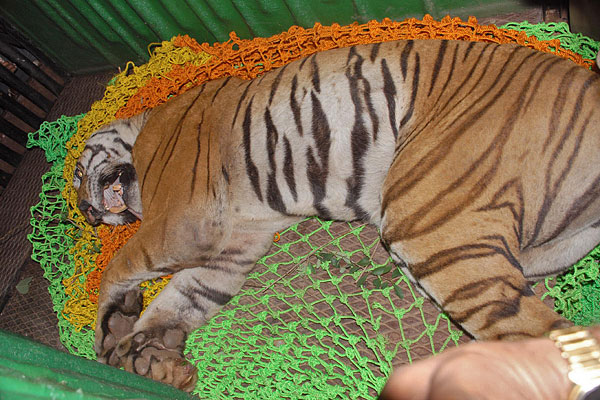News papers have been reporting the presence of a livestock killing tiger in agricultural fields and state forests outside the eastern boundary of Nagarahole Tiger Reserve over the last few days. Unfortunately on 25-August-2012 the tiger attacked a woman grazing livestock, killed, and partially ate her. On 26-August-2012 Forest Department staff managed to locate the tiger using domestic elephants, tranquilized it and moved it into captivity.
We have been carrying out long term monitoring of tiger populations in Karnataka using advanced camera trap survey methods for the last two decades. From the stripe patterns on the captured ‘man-eater’, we have identified the animal as NHT-222. This adult male that was first photo-captured on 6-May-2005 in Metikuppe Range of Nagarahole. From these first set of photos we estimated him to be about 3-4 years of age at that time. He has been subsequently camera trapped several times during our annual camera trap surveys. His last photo-capture was on 26-December-2011 during our current round of Phase IV monitoring conducted with the Forest Department.
However, in last week of May 2012, Forest Department patrols observed an injured tiger near Hosakere tank in Sunkadakatte area. From its photos we identified this tiger as NHT-222. It appears this 10-12 year old male tiger never recovered from this injury and has since been pushed out to the Reserve fringes. At the time of its capture it had serious injury on its front right paw. It also showed discolored and worn out teeth, with broken canines.
However, it is important to note that ‘fate’ of such individual tigers is not the issue here. The population in Nagarahole is at high densities, ranging between 10-12 tigers per 100 sq.km, and our studies show that about 22% of the population is lost every year from mortality and outward dispersal. NHT-222 has now become a part of this annual loss. However because of a rich prey base tigers are reproducing well in Nagarahole-Bandipur, with resident females producing large litters, easily making up for these annual losses.
Since NHT-222 is old, and has lost his home range in Nagarahole, and he now has a record of actually killing and eating a human being, and even being aggressive towards the tracking party, releasing it back into the wild is not at all a safe option and such a move will put more human lives at risk.
Our studies clearly show that the populations in Nagarahole-Bandipur are at high densities (10-15 tigers per 100 sq.km), despite annual losses of 20% from mortalities and dispersals. This individual is one such animal that now has to go out to make room for another younger animal in that population.
This incident highlights the value of serious and continued monitoring of tiger source populations and how it assists in making informed decisions.


 CI is a non-profit, non-commercial portal that aims to facilitate wildlife and nature conservation by providing reliable information and the tools needed to campaign effectively.
CI is a non-profit, non-commercial portal that aims to facilitate wildlife and nature conservation by providing reliable information and the tools needed to campaign effectively.
So what is the way out of this:
1) Is it shifting the helpless feline to a zoo where it will spend the rest of its life in captivity.
2) Euthanize it.
Actually its a good idea, because the animal will get daily healthy meal and it can survive for more years.
I read in Deccan Herald today that this tiger is not a man-eating tiger (after analysis of fecal samples) and it seems that the human being was most probably eaten by other animals. So what next?